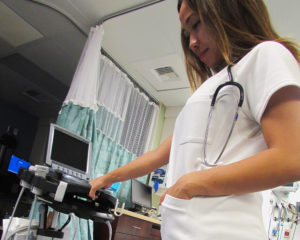Developing fibers and fabrics to help keep health care workers safe.

During his 12 years as an emergency department paramedic, Arthur Lucero had to purchase his own scrubs. He thought he could make a better product, and tried bamboo fabric for its organic nature, antimicrobial properties and comfort. But the drape was too heavy, it shrank, and it wasn’t durable enough to suit him.
“I put the project on hold and was waiting for fabric technology to mature. Then in 2012, [athletic clothes manufacturer] lululemon began gaining significant traction by blending yarns that gave their consumers a desired effect,” Lucero says. “It caught my attention, and I became a fan. But I wasn’t the only one. I began to see a number of Kickstarter projects from other entrepreneurs popping up left and right using advanced yarns in performance fabrics. I thought to myself, ‘If they can do it, why can’t I—but in medical apparel?’”
A market study he read indicated that U.S.-based scrub retailers grossed more than $1.9 billion in 2014—the same year the Los Angeles resident formed FIT Scrubs®. “I discovered the antimicrobial effectiveness of silver-embedded yarns,” he says, adding that the company that seemed to be “leading the charge” was PurThread Technologies Inc. of Cary, N.C.
“I found PurThread on materialconnexion.com and followed up via LinkedIn, where we began a dialogue,” he says. PurThread creates antimicrobial staple fibers and continuous filament yarns for antimicrobial products ranging from mop heads to hospital scrubs. The company devised a proprietary process to embed Kodak’s EPA-registered silver salts into fibers at the molten stage of fiber production, and has optimized the process over years of research and development.
At the U.S. Department of Commerce/IFAI-hosted Smart Fabrics Summit in Washington, D.C., this past April, Scott Ballenger, senior vice president of business development for PurThread, shared his presentation time with Lucero. “We provide antimicrobial fibers to his specifications, as well as quality assurance testing on his products,” Ballenger says. “We have collaborated along the way to help him achieve his goal.”
“One of the biggest challenges early on was finding a fabric mill to work with us to create that perfect antimicrobial, performance-driven fabric blend,” Lucero says. “Woven fabrics were not meeting our expectations in regard to the breathability factor I sought. So we ventured further to develop a knit blend. I visited North Carolina State University’s College of Textiles and discussed our challenges with the staff. With the knowledge I gained from their expertise on how to navigate knit downs and develop sample rolls, I figured out how to approach our fabric initiative and communicate my vision to a fabric mill in Los Angeles using PurThread’s yarn. From there, it was a wholehearted collaborative effort by PurThread’s technical team, our fabric mill’s textile engineers, and my ability to express the particular wants and needs of the medical community for a functional uniform.
“There has been a generalized norm to create fashion-oriented scrubs that focus on colorful prints with a lighthearted approach,” he continues. “But no one has yet to take a stance on empowering our health care professionals with a uniform that they can depend on—and that’s our agenda.”
Janice Kleinschmidt is a writer and magazine editor based in San Diego, Calif.
 TEXTILES.ORG
TEXTILES.ORG


